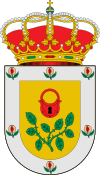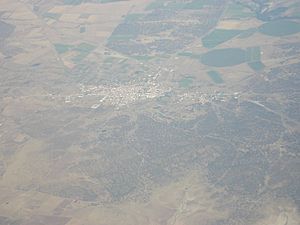Zarza de Granadilla facts for kids
Quick facts for kids
Zarza de Granadilla, Spain
|
|||
|---|---|---|---|
|
municipality
|
|||
|
|||
| Country | Spain | ||
| Autonomous community | Extremadura | ||
| Province | Cáceres | ||
| Municipality | Zarza de Granadilla | ||
| Area | |||
| • Total | 134 km2 (52 sq mi) | ||
| Elevation | 399 m (1,309 ft) | ||
| Population
(2018)
|
|||
| • Total | 1,823 | ||
| • Density | 13.60/km2 (35.24/sq mi) | ||
| Time zone | UTC+1 (CET) | ||
| • Summer (DST) | UTC+2 (CEST) | ||
Zarza de Granadilla is a town in Cáceres Province, Extremadura, Spain. It is a municipality with about 1,800 people living there.
This town is in the north of Cáceres province. It sits between the Ambroz and Alagon river valleys. Zarza de Granadilla shares borders with several towns. These include Abadía, La Granja, and Casas del Monte to the east. To the south are Jarilla, Villar de Plasencia, and Guijo de Granadilla. To the west, it borders Mohedas de Granadilla, La Pesga, and Caminomorisco. In the north, it meets Sotoserrano and Lagunilla, which are in a different region of Spain. The total area of the town is 134 square kilometers.
Contents
About Zarza de Granadilla
This village was once known as Lugar de las Zarzas. That name means "Place of the Brambles." It was a popular resting spot for sheep herders. Millions of sheep from León and Castile passed through here each year. They used a special path called the Cañada Real de las Merinas.
The town started in the 1500s. An illness spread through the area. So, the Duke of Alba, who owned the land, let people settle here. They built the main square and the church of Nuestra Señora de la Asunción. This church is on the highest part of the town. Inside, you can see a beautiful golden wooden altar. There is also a small chapel called Cristo de la Misericordia. It was built in the 1700s.
The Gabriel y Galán reservoir is very close to the town. This big lake is great for fun activities. You can enjoy its beaches, go fishing, or try water sports. Zarza de Granadilla is surrounded by mountains. But to the south, there are many green meadows. This area is part of the fertile Ambroz plain. The town is known for its paprika. They also make tasty traditional sausages. These include chorizo, pumpkin and potato sausages, and cured pork.
Granadilla Village
The village of Granadilla is on a hill. King Don Fernando of León founded it in 1170. It was first called Villa de Granada. Later, it was renamed Granadilla. In 1911, it became part of the Order of Santiago. Over time, different lords and kings ruled it. In 1446, King Juan II gave it to Fernando Álvarez de Toledo. It then belonged to the House of Alba for many years.
The town has a strong castle. It is called the Castle of Granadilla. This castle was built for defense using granite stones. Next to it are parts of its old Almohad wall. You can still see "longueras" inside the walls. These were enclosed gardens. They were important for food during attacks.
Granadilla was abandoned when the reservoir was built. The water flooded most of its land. But now, the town is being restored. You can visit this old fortified village.
History of the Town
Zarza de Granadilla was founded in the 15th century. It was first called La Zarza. Later, it joined with Granadilla. This happened when Granadilla village was left empty. Most of its land was flooded by the Gabriel y Galán reservoir.
There are some interesting old buildings to visit. The church of Nuestra Señora de la Asunción is from the 1500s. The chapel of Cristo de la Misericordia was built in the 1700s.
If you like good food, you should try the local dishes. The town is famous for its sausages and sweets. These include "coquillos," "perrunillas," "floretas," and fried doughnuts.
You should also visit the old village of Granadilla. It is being restored. You can see parts of its old Almohad walls. There is also a medieval castle and its church.
The Provincial Museum of Cáceres has some old items. These are from the Visigothic period. They found belt buckles with shiny stones in Zarza de Granadilla.
What People Do for Work
Most people in Zarza de Granadilla work in farming. About 40% of the people work in agriculture. Another 20% work with livestock. This means raising animals.
About 15% of the people work in industry or construction. The remaining 25% work in services. This includes jobs like shops, schools, and healthcare.
For farming, they mostly grow cereals and pasture for animals. They also have some olive trees. In irrigated areas, they mainly grow tobacco and paprika.
Population Information
In 1842, the town had 230 homes. There were 1280 people living there. In 1965, the town grew bigger. It took in a part of Granadilla that was not flooded. This included the village itself.
In 2020, the population was 1800 people. There were 911 men and 889 women.
Sports and Recreation
Zarza de Granadilla has a special sports center. It is called the International Centre for Sports Innovation in the Natural Environment. It is located on a piece of land that sticks out into the Gabriel y Galán reservoir.
This center is shaped like a ring. So, people often call it "The Ring." It was built to help people practice and learn about different sports. It also helps with sports research. The center opened in 2011.
In the summer, the town's public swimming pool is a popular spot.
Important Buildings
- Catholic parish church of Nuestra Señora de la Asunción: This church was built in the 15th century.
- Hermitage of Cristo de la Misericordia: This small chapel is from the 18th century.
- Despoblado de Granadilla: This is the abandoned village of Granadilla.
- Castle of Granadilla: An old castle in the abandoned village.
Town Celebrations
- Romería de la Virgen de Fátima: This is a traditional pilgrimage. It happens on the first Sunday in May. It is different from another pilgrimage held two Mondays after Easter. This one takes place near the Argamasa and Horno streams.
- Procession of San Cristóbal: This event is on the first Sunday in July. Local vehicles take part in a parade.
- San Ramón Nonato: This is the town's patron saint day. It is celebrated on August 31st.
Public Services
- Education
The village has a school called CRA Ambroz. It is a rural grouped school. Children from Abadía, Casas del Monte, and La Granja also go there. For older students, there is IESO Cáparra. Here, you can study for four years of ESO. You can also learn to be an Administrative Services Assistant. There is also a Tele-centre next to the library. It helps people learn computer skills.
- Health
The town is part of the Aldeanueva del Camino health area. This is within the larger Plasencia health area. It has a place for continuous care.
See also
 In Spanish: Zarza de Granadilla para niños
In Spanish: Zarza de Granadilla para niños




